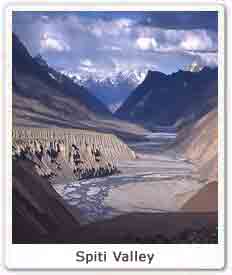The beautiful valley of Spiti originates from the 16,000 feet high Kunzum range. The spectacular valley is located on the Tibet India Border. The scenic beauty of the spiti is beyond ones imagination. This is the high altitude cold desert, is in the North east of the Indian hill state of Himachal Pradesh. River Spiti flows in the Spiti valley in the eastward direction to join Sutlej river near the village of Khab and Kinnaur. It is believed that the Spiti was ruled by local rulers (Nonos) for centuries. Later in the 10th century, Spiti was given to the one of the son of the King of Ladakh. Spiti got freedom after the Ladakh Tibet war in the year 1681-1683. Now Spiti is the independent part of the district of Lahaul-Spiti in Himachal Pradesh. The valley is studded with wide variety of attractions like snow covered mighty mountain peaks, imposing monasteries, rugged terrains, adventurous treks, beautiful lakes and glaciers. The month from May to October are the best time to visit the Spiti Valley.

The magnificent mountain ranges in the Valley of Spiti belongs to the great Himalayas. Rocky hills, steep slopes and gorges in Spiti serve as a surprise gift to the visitors. During the summers the vegetations forms the huge bed layer in the Valley making it more charming and beautiful. Rainfall is quite low in the area as compared to the snowfall. Snowfall is the main source of water, which serve the purpose of irrigation in the fields. Spiti enjoys the same vegetation and climate as the Tibet. That is the reason It is called as the 'Little Tibet'.
Buddhism in Spiti Valley :
People in Spiti are highly spiritually. Spiti is popularly called as the land of lamas. The Valley is dotted with the numerous Buddhist Monasteries. There are aslo large number of Gompas in Spiti. The major population in the Spiti is the firm follower of the Buddhism. Some pf the most famous Gompas and Monasteries in the area are Kye Monastery, Thang Yug Monastery, Kungri Gompa, Dhankar Monastery, Tabo Manastery, Gungri monastery and many more. Apart from the monasteries tourists can make a visit to the Kunzum Pass (gateway to the spiti) which provides the astonishing view of the Bara Sigri Glacier, Losar famous for the streams and Pin Valley ( the popular Chaumurti horses are found here). Other interesting places in Spiti include Kaza, Lhalung, and Kibber.
Wildlife of Spiti Valley : The valley is endowed with the wide variety of animal species like the popular Himalayan fox, Himalayan Tahr, Himalayan Brown bear, snow leopards, Musk deer, and Himalayan Blue Sheep which serves as the boon for the wildlife lovers. The valley also has rich flora and is known for its profusion of wild flowers through out the year. You may find fields where villagers grow barley, buck- wheat, peas and vegetables. Agriculture is the main occupation practiced here. The tour to the Spiti Valley provides the excellent opportunity to experience the culture of the tribal people. Te people in the region are known for the simplicity and honesty. Bhoti is the common language spoken in the Spiti Valley.
Adventure Activities in Spiti Valley :
The increasing adventure activities in Spiti are attracting more number of tourists every year. The spitian peaks are enthralling for the adventure enthusiasts as it provides the magnificent trekking routes and climbing possiblities during the summer season. The area provides the beautiful camping sites. Motor biking is the adventure sports which the tourists can try out on the tour to Spiti. If you are interested in exploring the villages of the valley than Jeep safari, will be most suitable. Yak and Horse ride are also conducted in the area, for the cherishing memories.






